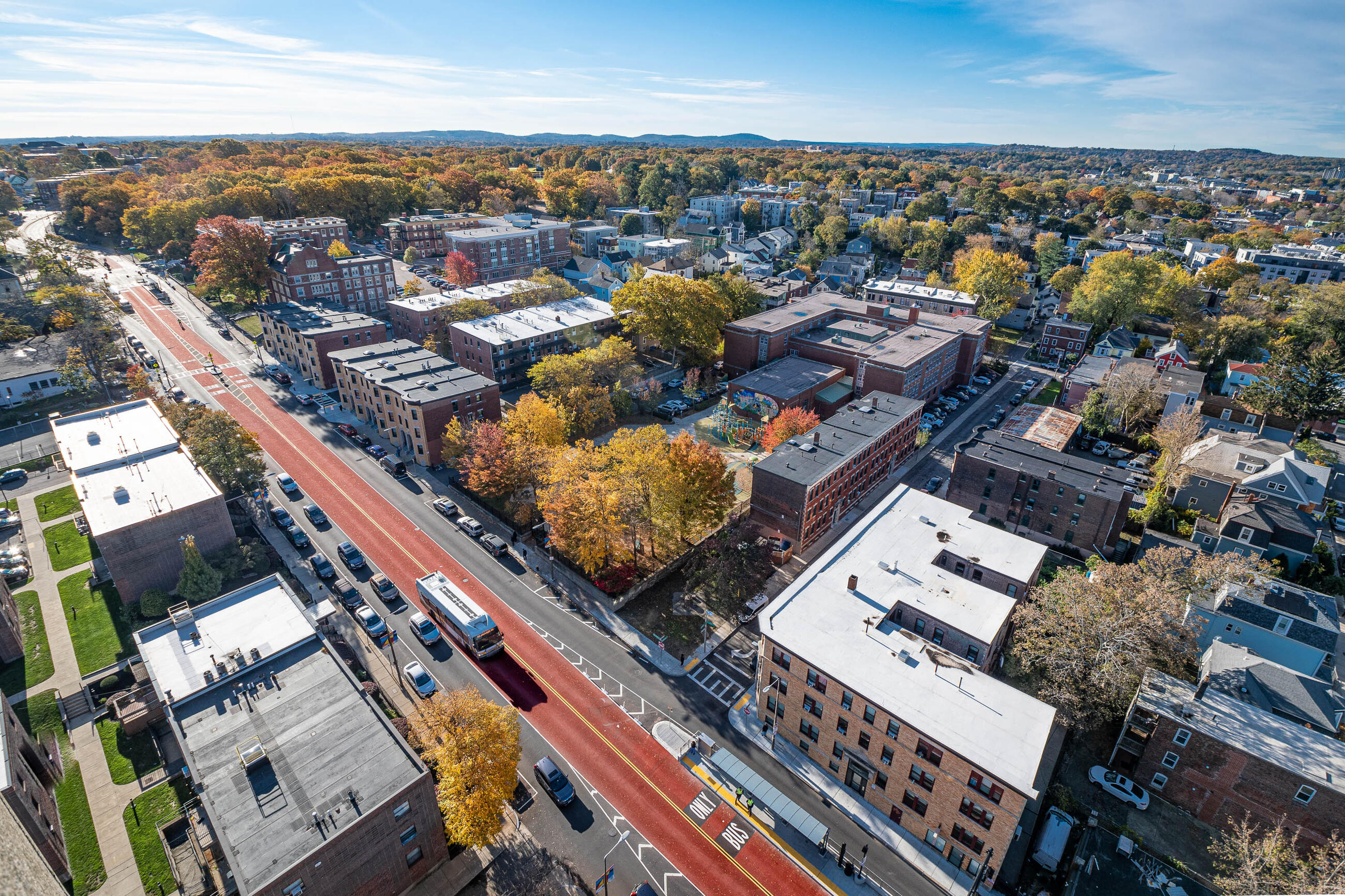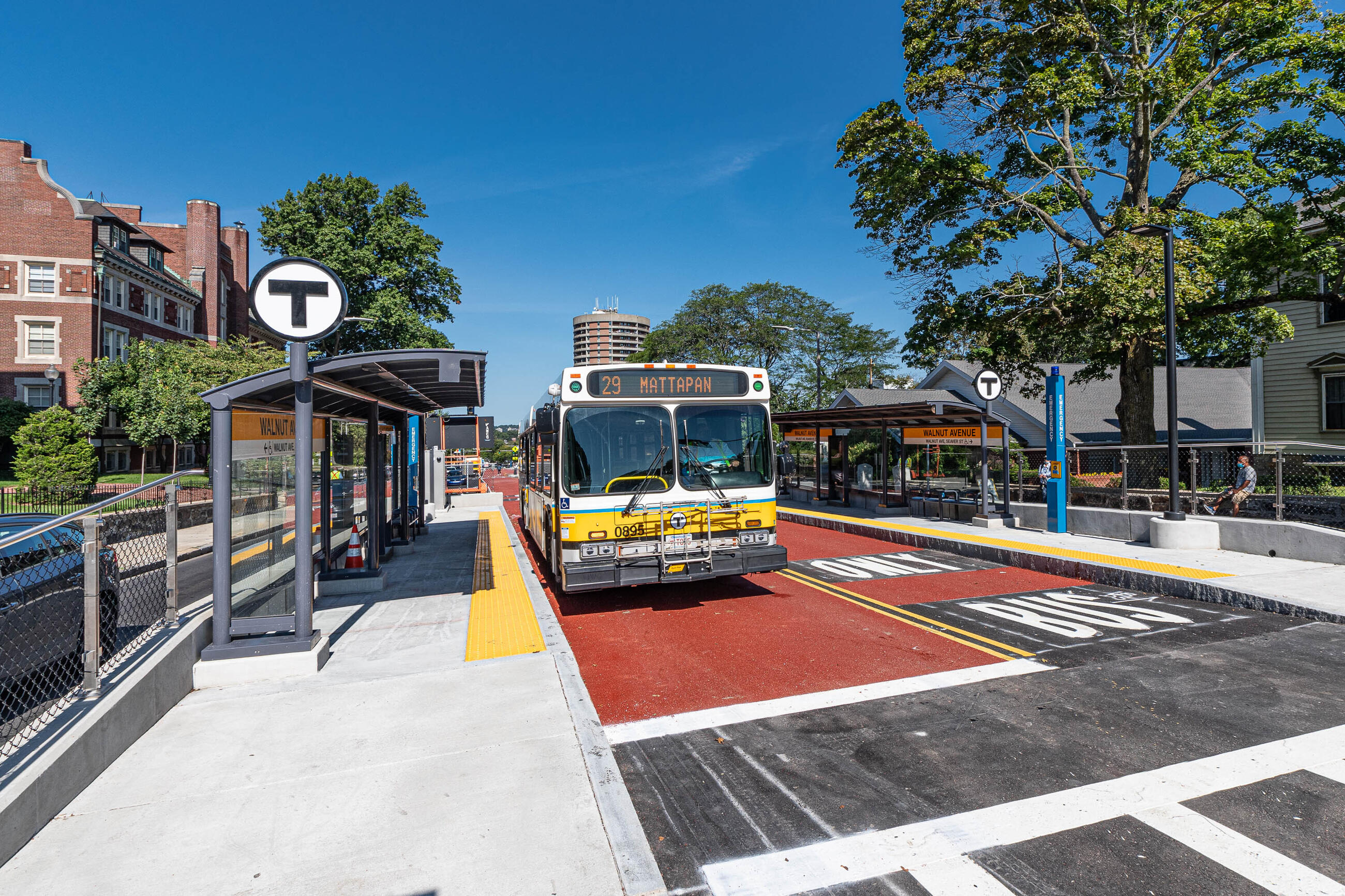MBTA and City of Boston Cut Ribbon on New England’s First Center-Running Bus Lane on Columbus Avenue
Posted on November 4, 2021
The ground-breaking Columbus Avenue bus priority facility is a transformative investment in transit reliability for nearly 10,000 weekday commuters in Mattapan, Dorchester, Roxbury, and Jamaica Plain.
The nearly mile-long center-running bus priority facility between Franklin Park and Jackson Square Station includes enhanced bus stop amenities, accessible boarding islands, traffic calming measures, and improved pedestrian safety treatments.

BOSTON – Today MassDOT Secretary and CEO Jamey Tesler, MBTA General Manager Steve Poftak, City of Boston Mayor Kim Janey, community leaders, and advocates celebrated the completion and opening of a transformative transportation project: a center-running bus lane facility on Columbus Avenue between Walnut Avenue and Jackson Square Station in Boston. The corridor is the first center-running bus lane facility in the MBTA service area and in New England, and is anticipated to save riders 4 – 7 minutes on Bus Routes 22, 29 and 44 traveling along the nearly mile-long corridor. Bus operations began in the bus lanes along Columbus Avenue starting Saturday, October 30, 2021.
The ribbon-cutting event celebrated the completion and opening of the project, which has been under construction since August 2020. In the wake of the COVID-19 pandemic, the City of Boston and the MBTA prioritized implementation for the Columbus Avenue project due to the continued need for bus priority. After the statewide public health emergency was declared in March 2020, ridership for Bus Routes 22, 29, and 44, which travel through the project corridor, were well above system-wide averages. These routes also serve some of the highest rates of low-income and minority riders within the MBTA’s system. Prioritizing trips for these riders at this time is a critical part of making it easier for riders to access workforce opportunities, education, and critical services in the months and years to come as the region recovers.
“We appreciate the collaborative efforts of the City of Boston, business community, local leaders, and transit advocates which have helped the MBTA deliver on its commitment to aggressively complete capital projects that are vital to improving safety and service for riders and pedestrians,” said Transportation Secretary and CEO Jamey Tesler. “In spite of continued challenges brought about by the pandemic, the MBTA has succeeded in opening this center-running bus lane with new stations and other amenities and in moving ahead with other projects to repair or replace core infrastructure, track, signals, and power.”
The transit enhancements were designed to dramatically improve bus reliability and accessibility for riders relying on three chronically delayed MBTA routes connecting Mattapan, Dorchester, Roxbury, and Jamaica Plain with the Orange Line, Red Line, and the rest of the transit system. Important accessibility improvements include bus stop boarding platforms with large digital panels dedicated to real-time information that also include an audio component, allowing for the achievement of both visual and audible equivalency for riders with no or low vision and/or who are hard of hearing – a first for the MBTA’s bus network.
“I was so excited to join for the launch of the new Columbus Avenue bus lane. This design is the first of its kind in all of New England and it will serve over 8,000 daily bus riders who rely on the 22, 29, and 44 bus routes to connect to the MBTA transit system. These routes have had consistently high ridership throughout the pandemic,” said City of Boston Mayor Kim Janey. “Thank you to the MBTA, the Boston Transportation Department, and all of the community members and organizations that have come together to make our transportation safer, more accessible, and more equitable.”

“Here on Columbus Ave., a vision for the future of our bus system has taken hold, one where our riders can expect more reliable service, greater accessibility, improved safety, and enhanced customer amenities. We are proud to have partnered closely with the City of Boston to make this vision a reality, one that our riders will benefit from for years to come,” said MBTA General Manager Steve Poftak. “This project is just the first step. We are excited to continue to work with the City of Boston and our other municipal partners to roll-out similar projects in the years to come; extending similar benefits to riders systemwide.”
Installing bus lanes in the middle of Columbus Avenue, which are often called “center-running bus lanes,” allows for faster, more reliable service compared to curbside-running bus lanes by decreasing the likelihood that buses will be delayed by traffic, slowed down by turning cars, or stuck behind double-parked vehicles. In general, center-running bus lanes improve safety by reducing the number of conflicts as compared to side-running bus lanes because they are less affected by side streets, driveways, and motorists parallel parking. The MBTA and the City of Boston will continue to monitor the project’s impact in the weeks and months to come.

A major component of the project was the construction of four pairs of boarding platforms between Walnut Avenue and Dimock Street to allow riders to board and alight the bus. Each boarding platform includes several first-in-the-system upgrades, including near-level boarding to allow for easier access getting on and off the bus, digital screens providing real-time arrival information and other service updates, seating, and canopies to protect riders from the elements.
The new boarding platforms have the added benefit of serving as pedestrian refuges for people crossing Columbus Avenue. Compared to pre-construction conditions, people crossing Columbus Avenue in the project area now have considerably shorter distances to travel between travel lanes. Wherever necessary, crosswalk ramps on adjacent crosswalks were reconstructed to ensure greater accessibility, and a new crosswalk was built near the Boston Public Library location. In total, 49 pedestrian curb-ramps were reconstructed along the project corridor.
Combined, the new boarding platforms, bus lanes, and crosswalks also provide traffic calming benefits by providing motorists with more visual cues to slow down near crosswalks, creating safer conditions for all road-users.
“This is an important investment in making Egleston Square more accessible and welcoming for residents, visitors, and businesses,” said Carolyn Royce of the Egleston Square Neighborhood Association. “I see the dedicated bus lane on Columbus Ave. as addressing some long-held goals of Egleston Square Neighborhood Association to promote bus transit, increase walkability and pedestrian safety, and manage traffic. In addition to more reliable and efficient bus service for three high ridership routes, I welcome the beautiful new bus stops, with sheltered seating, handicap access, and other amenities, and the new crosswalks and signals that make it so much easier and safer to cross Columbus Ave.”
“This project has been a major step forward for the MBTA and Boston when it comes to closing our system’s transit equity gap,” said LivableStreets Alliance Executive Director Stacy Thompson. “Nine in 10 Route 22 riders are people of color, and they have disproportionately longer commuters compared to their fellow white bus riders. Every minute we can give back to riders on the 22 or the 29 or the 44 is a valuable investment toward making a more just, equitable, and sustainable city. We look forward to continuing to advocate for more transit improvements on behalf of riders in the months and years to come.”
The Columbus Avenue bus lanes project is a partnership between the MBTA and the City of Boston. Improving bus service is a priority for both the MBTA, which operates the service, and the City, which owns and manages the right-of-way along the corridor. The project is expected to be completed at a total cost of about $14 million (which includes construction, design, administration, and inspection costs) with about $13 million contributed by the MBTA and $1 million contributed by the City.
The City of Boston and the MBTA will continue to work with the community along Columbus Avenue post-implementation to engage riders and residents about the new facility. The Boston Region Metropolitan Planning Organization (MPO) recently green-lighted funding to support extending the center-running bus lane corridor north along Columbus Avenue from its current terminus at Jackson Square to Ruggles Station in order to extend reliability benefits for thousands of daily riders who rely upon that section of Columbus Avenue and Tremont Street. The MBTA is partnering with several other municipalities within the service area to deliver bus priority projects wherever they are needed.
The MBTA continues to partner with MassDOT, the City of Boston, and other municipalities to build a network of high-quality bus priority infrastructure across the MBTA service area, including Summer Street between Dorchester and Atlantic Avenue, North Washington Street in the North End, North Common Street, South Common Street and Market Street in Lynn, the Tobin Bridge, and Broadway in Chelsea.
This project is a key component of the MBTA’s Rapid Response Bus Lane Program, a major initiative to improve bus service starting in summer 2020 in the wake of the pandemic, and the City of Boston’s Healthy Streets initiative, an effort to respond to COVID-19 crisis by doubling down on the City’s Go Boston 2030 goals: equity, economic opportunity, and climate responsiveness.
The MBTA Transit Priority Group was created in 2019 with support from the Barr Foundation to further bus priority projects around the region. The group has worked closely with municipal partners and MassDOT to deliver over 13 miles of bus lanes and activate transit signal priority at 85 locations in six cities, more than doubling the MBTA service area’s bus priority network in the last two years. These reliability benefits have had a far-reaching impact. While 3% of passenger miles travelled are in bus lanes, reliability benefits extend to 41% of passenger miles travelled system-wide.
More Information
Media Contact Information
For all queries and comments, please contact:
Recent News on the T
April 22, 2024
April 18, 2024
April 18, 2024
April 18, 2024